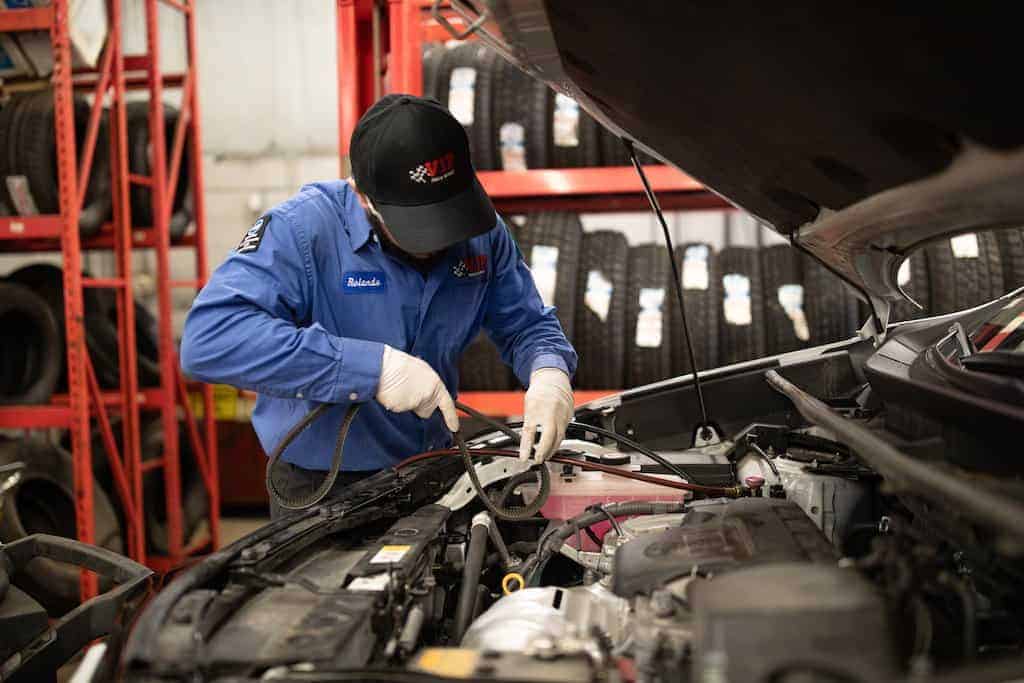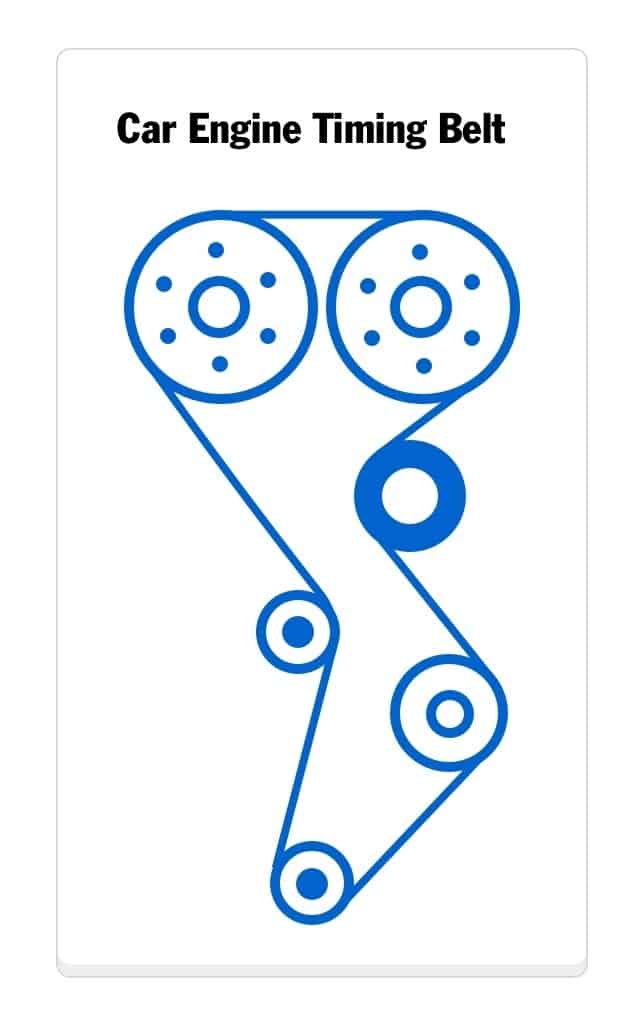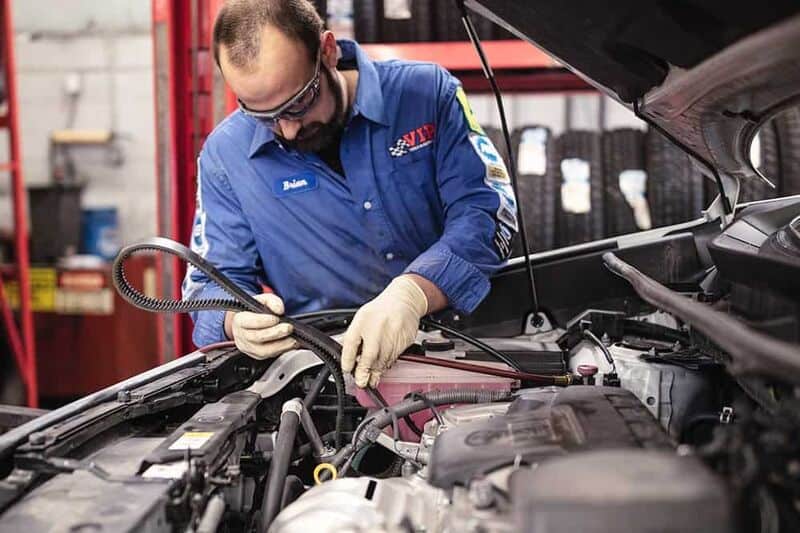What Is the Average Timing Belt Replacement Cost?

Your vehicle’s engine is a finely-tuned balancing act — every part needs to function correctly and in sync with each other. That’s where the timing belt comes in. Timing belts regulate the mechanical timing of the engine, and if it breaks, the best you can hope for is that your engine stops running and your vehicle will coast to stop. A timeline belt failure can cause catastrophic damage to your engine, requiring the repair and replacement of thousands of dollars in parts.
Comparatively, replacing your timing belt is inexpensive, though its full cost will depend on a variety of factors, such as the engine type, maintenance, driving conditions and more. According to our experts, the average timing belt replacement cost will range between $400 and $1,000.
There’s a lot more to consider about a timing belt replacement cost, so read on for more information about what you can do to reduce costs and care for your engine.
What Is a Timing Belt?
How Does a Timing Belt Work?
Inspection & Replacement Process
When to Replace Your Timing Belt
How Much Does It Cost?
Additional Associated Repairs
How to Save Money on Timing Belt Replacement
Timing Belt Replacement with VIP Auto
FAQs About Timing Belt Replacement & Costs
What Is a Timing Belt?
The timing belt itself is located inside the engine beneath the timing cover. Typically made from rubber reinforced with nylon, the timing belt typically has square teeth on the inside surface that are meant to latch onto the sprockets of the camshaft and crankshaft.
Most modern vehicles use timing belts, whereas older vehicles use steel timing chains which operate in the same manner to synchronize an engine’s functions. While timing chains last longer, they are also heavier and more complex than belts, which are quieter and cheaper to produce and replace.
Timing belts are considered a wear item, which means they’re intended to be replaced at regular intervals. Most timing belts are changed every 60,000 to 90,000 miles as part of preventive maintenance.
If a timing belt breaks, the engine will stop and the vehicle will coast to a stop. The larger problem comes with a catastrophic failure, where the valves and pistons will collide with each other as they go out of sync, causing extensive damage to the rest of the engine.
Representation of a timing belt, crankshaft and camshaft.
Components controlled by the timing belt
Crankshaft: The mechanical component at the bottom of a motor that converts the vertical motions of pistons into a horizontal rotational movement. This motion is what drives the timing belt.
Camshaft: Located at the top of the motor, the camshaft (which can include up to four per engine) is driven by the timing belt. When the camshaft rotates, it activates the engine’s intake and exhaust valves — opening and closing them.
Valves: Provide air and fuel to the cylinders and expel combustion gasses to the exhaust system.
Cylinders: Composed of a piston and an inlet and exhaust valve, cylinders are the power generating component. Fuel is combusted in the cylinder and converted into mechanical energy.
Pistons: Pistons transfer the force generated by fuel combustion to the crankshaft.
How Does a Timing Belt Work?
As the crankshaft turns, the timing belt transfers the rotation to the camshaft, which activates the engine’s valves to provide air and fuel to the cylinders and expel combustion gasses to the exhaust system.
The valves and pistons are constantly moving up and down at very high speeds and are meant to operate in sync. When the pistons are down, the valves are open; when the piston is at the top of its travel, the valves are closed. Some engines — called interference engines — are so tightly designed that they don’t have any clearance between a valve at its lowest point and a piston at its highest.
Timing belts ensure that everything is synchronized, helping to prevent any collisions or damage to the valves, pistons, cylinder head or cylinder walls.
Read more about the importance of timing belts in our companion blog post: Why Your Timing Belt Matters.
The Timing Belt Inspection & Replacement Process
Your owner’s manual will detail all important maintenance for your vehicle, including a schedule for timing belt replacement. Most manufacturers will recommend a replacement every 60,000 to 90,000 miles. However, miles are only one indicator of the wear on your timing belt. Time and the elements will also degrade the rubber of a timing belt, so even a low-mileage vehicle may need a replacement if it’s been in operation for several years.
Your car manufacturer will also have recommended intervals to inspect the condition of the timing belt to check for premature wear or damage. One way to keep timing belt replacement costs down would be to perform a DIY home repair, but understand that timing belts are one the most difficult parts to get to in a vehicle. If you want to check your timing belt, you’ll need to:
- Disconnect the negative battery cable. You may need to remove the battery to access the timing belt area.
- You may also need to remove the wiring harness and fan shroud assembly to create more workable room.
- If your engine has a distributor cap, you’ll need to remove that as well.
- You also may need to remove the drive belt, or the serpentine belt, to get to your timing belt. This will require loosening the crankshaft pulley bolts.
- Remove the crankshaft pulley and then the timing belt cover.
- Now you can do your visual inspection.
Once you have open access to the timeline belt, here’s what you want to look for:
- With the drive / serpentine belt removed, bend it to inspect its surface for separating layers, cracks or split.
- Check for proper alignment of the crank and camshaft timing marks. This may be a dot or index line on the pulleys and/or sprockets that should line up with corresponding marks on the block, cylinder head or accessory shaft.
- Look around the camshaft and crankshaft seals, as well as the valve cover and oil pan, for signs of oil leakage.
- Check the area for coolant leaks from the water pump and water pump by-pass hose.
- Remove and inspect the timing belt for cracks, fraying, or if it’s missing chunks from its teeth on the underside.
- Check the tension of the belt to see if it feels loose and the tensioner pulley for signs of damage or worn bearings.
When to Replace Your Timing Belt
If your belt has any evidence of excessive wear — such as cracks, splits or cuts, then it’s time for a new timing belt. If any of the underside teeth are damaged, then you’ll also have to replace the belt. If you notice that the timing belt is soaked in oil leaking from the engine or water from a leaking water pump, then you’ll have to repair that leak and likely replace the belt as well.
If you want to DIY the timing belt replacement, you will need:
- To have the right tools to remove and replace any parts, including any speciality tools required for your car’s specific engine components.
- Access to the manufacturer’s shop manual for the recommended replacement timing belt for your vehicle’s specific model vehicle and engine type.
- To inspect the engine valves for damage if you’re dealing with a broken timing belt.
Take care! Making a mistake with the replacement belt — or even putting everything back into place — puts your engine at risk for serious damage. If you’re not experienced in working with engines, then consider having a certified automotive professional perform the inspection and replacement. Having everything done exactly right is worth the cost to replace the timing belt and any other related parts.
How Much Does It Cost to Replace a Timing Belt?
As with any automotive repair, the total cost for a timing belt change will depend on a number of factors, including the make and model of the car. A typical timing belt will only cost between $25 and $50, but the time involved in the repair takes at least a few hours.
On average, the estimated cost for a timing belt replacement for a smaller car will be anywhere from $500-$800, while a larger SUV or minivan will cost on average $700 to over $1,000. This is only a general price range, as any cost estimate will need to be personalized to your vehicle and its condition. Your location will also affect the relative price. Here’s a range of timing belt repair costs near the Boston area for some popular makes and models, according to Kelley Blue Book:
Sample Timing Belt Replacement Costs, Parts and Labor
| Honda Odyssey, 2010 | $1,283-$1,418 |
| Honda Accord, 2019 | $1,230-$1,360 |
| Nissan Pathfinder, 2000 | $978-$1,090 |
| Toyota Camry, 1998 | $941-$1,047 |
| Subaru Legacy, 2013 | $909-$1,011 |
| Hyundai Santa Fe, 2005 | $833-$927 |
| Subaru Forester, 2002 | $805-$909 |
Additional Repairs Commonly Associated with Timing Belt Replacement
It’s highly recommended that when you replace your timing belt, you have other related parts repaired or replaced as well. Chances are high that other related parts — such as pulleys, the drive belt, tensioner pulley and the water pump — are also worn and in need of replacement. These are usually worth replacing if they show wear or signs of failure. Additionally, timing belt replacement usually requires removal of the engine drive belt and other components to reach the timing belt, which adds to labor costs. It can be more cost effective to replace multiple parts at once, rather than at different times.
- Average water pump replacement cost, parts and labor — $753-$900
The water pump is what pushes coolant from the radiator out through the engine. Water pumps are generally inexpensive, with the cost of labor being far more than the pump itself. Because the water pump usually has to be removed when changing the timing belt, it makes a lot of sense to do both at the same time. - Average timing belt tensioner replacement cost, parts and labor: $369-$464
The tensioner keeps the timing belt tight and operating without any slack, which keeps it aligned and prevents it from falling off of the track. Chances are, if your timing belt needs replacing, a pulley or tensioner probably needs replacing as well. This is especially true if the timing belt has failed, as these parts were likely damaged. - Average camshaft seal replacement cost, parts and labor: $556-$702
Front engine seals are vital for retaining engine oil and protecting against dirt or other contaminants. These seals see a lot of abuse from the constant pressure of the timing belt and their failure causes problems not just for the timing belt but for the entire engine. The part cost for replacing these seals is fairly nominal, so save on labor and have them replaced along with the timing belt.
How to Save Money on Timing Belt Replacement
The best way you can save money on your timing belt replacement is to get it done during the regular intervals recommended by your car’s manufacturer. Yes, timing belt replacement isn’t cheap, but it’s far less expensive than having to replace it and other damaged parts when it breaks. There are a few other steps you can take to save some extra money.
- Keep up on preventative maintenance. An ounce of prevention is worth a pound of cure, and that saying is just as true for cars. Regular maintenance keeps all of your vehicle’s parts working optimally, which reduces the stress and wear on other parts.
- Get more done at once. Like mentioned above, the more you can save on labor, the more you’ll save in your bank account. If your timing belt needs to be replaced, get the other related parts changed out at the same time to save yourself future headaches.
- Determine what you can DIY. If you’re experienced at working on cars, then you could consider inspecting and even replacing the timing belt yourself — provided you use the recommended parts and follow every step of the replacement process. If the most upkeep you’ve ever done for your vehicle is to change the oil or a tire, then it’ll be easier — and likely less expensive in the long run — to leave the work up to a certified professional automotive professional.
Timing Belt Replacement with VIP Auto
Look no further than VIP Tires and Service for professional inspection and replacement for your timing belt. Our certified automotive professionals will examine all parts to check for anything that needs to be replaced. When they do replace a part, they’ll take precise measurements to ensure that everything aligns correctly and that your vehicle runs optimally. Plus, we offer a warranty on most installed parts and a labor warranty that matches the warranty on installed parts.
Read more about VIP Auto’s expert Timing Belt Replacement services, and please call us at any time to schedule your next service appointment.
FAQs About Timing Belt Replacement & Costs
How does a timing belt work?
The timing belt is a rubber belt that controls the camshafts in your engine, opening and closing valves at just the right time for smooth operation. The timing belt has teeth that turn the camshaft in time with the crankshaft.
How often do I need to replace my timing belt?
Most timing belts are changed every 60,000 to 90,000 miles as part of preventive maintenance.
Can I replace my own timing belt?
If you have the manufacturer’s recommended parts, the correct tools and detailed instructions on how to access your timing belt, it’s possible to replace it yourself. If you are not experienced with working on your car’s engine, it’s recommended to let a certified automotive professional handle the work.
How do I know when I need to replace my timing belt?
Replace your timing belt based on your owner’s manual recommendation or if it has cracks, cuts, is soaked in oil leaking from the engine or water from a leaking water pump or shows signs of excessive wear.
Visit us at one of over 65 locations throughout the Northeast. Walk-ins Welcome!
Schedule Service Get a Free Quote
